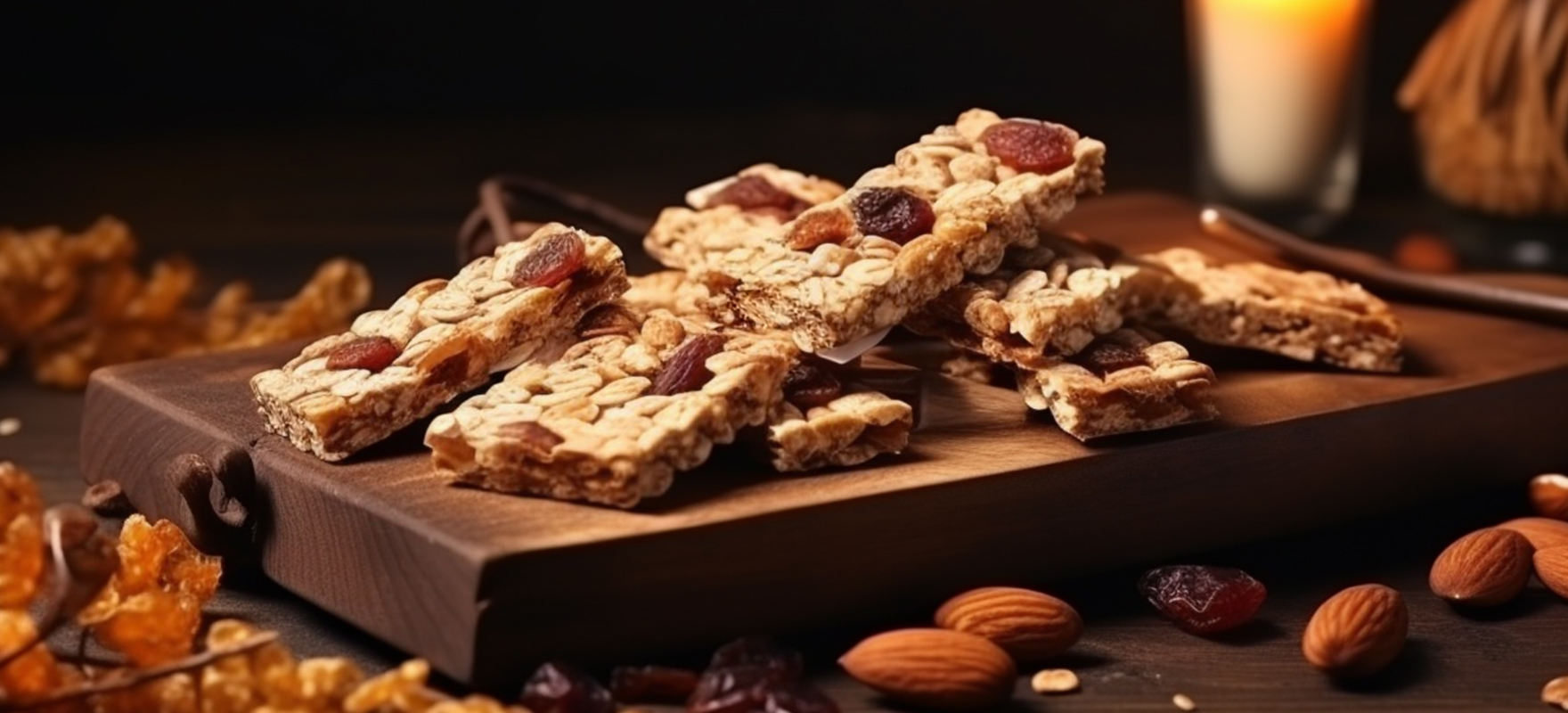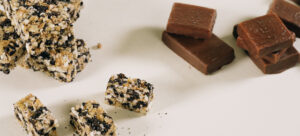Research has shown that the way you start your day can have a significant impact on your overall well-being. One powerful choice is to opt for a high-protein, high-fiber breakfast in the form of customizable cereal bars. This simple shift can lead to a 5% reduction in calorie intake during lunch when compared to conventional high-fat and refined carbohydrate breakfasts (Williams et al., 2006).
From Bowel Health to Cholesterol Control: The Fiber-Rich Benefits of Cereal Bars
But the benefits of cereal bars go beyond calorie control. Studies by Smith and Wilds (2009) suggest that consuming cereal bars in the morning enhances mental health and cognitive performance when compared to less nutritious morning snacks like crisps, sweets, biscuits, and cakes. Moreover, cereal bars rich in fiber provide a convenient solution for maintaining intestinal health, regulating bowel movements, and reducing issues like constipation and diarrhea (Slavin, 2013; Hess and Slavin, 2017). The incorporation of fiber-rich pseudocereals, such as quinoa, into cereal bars can offer additional health benefits, as observed in a study where young adults who consumed quinoa bars for 30 days experienced lower total cholesterol, LDL cholesterol, and triglyceride levels (Farinazzi-Machado et al., 2012).
However, it’s crucial to recognize that the nutritional quality of cereal bars can vary significantly due to the diversity of ingredients they contain (Sharma et al., 2014; Aleksejeva et al., 2017; Curtain and Grafenauer, 2019). While cereal bars are often rich in fiber, they can also contain high levels of sugar, particularly in the binder, accounting for up to 30% of the total product weight (Aleksejeva et al., 2017; Curtain and Grafenauer, 2019). The challenge is to find the right balance between technological, sensory, and nutritional qualities when replacing sugar as a binder in cereal bars.
Innovative Ingredients, Customizable Choices: The Evolution of Functional Cereal Bars
As consumers become more health-conscious, cereal bars are evolving from standard products to customizable offerings with various functional ingredients (Pallavi et al., 2015). In Europe, the snack bar market has seen a surge in recipes with high protein content (Mintel). Protein fortification remains a highly demanded trend in the food industry, especially among snack bar consumers. Recent research has demonstrated that a high protein content claim on cereal bars increases consumer interest, particularly among exercisers and men (Salazar et al., 2019). Brands are exploring alternative protein sources, such as pea, lupin, and lentil proteins, and sometimes even microalgae or insect proteins (Mintel). Surprisingly, wine fermentation residues have been considered a viable and sustainable alternative to increase protein content (Borges et al., 2021).
For those seeking both energy and sensory satisfaction, a study on high-energy cereal bars reveals that it’s possible to create CBs with excellent texture properties and high consumer acceptance, using ingredients like cereals, nuts, seeds, mixed fruits, corn syrup, and honey (Samakradhamrongthai et al., 2021). In the Asia Pacific market, snack bars that provide an energy boost are gaining new relevance, particularly among mentally exhausted consumers (Mintel).
With the growing appreciation for dietary fiber’s positive effects on the digestive tract, energy balance, and the prevention of non-communicable diseases (Garcia et al., 2012; Marques et al., 2015; Hess and Slavin 2017), high-fiber bars are gaining traction.
The demand for personalization is also on the rise, with some cereal bar manufacturers offering the option to customize both packaging and ingredients for tailor-made cereal bars. Personalization proves to be a powerful hook for consumers (Mintel).
Ingredient Insights: Unveiling Market Trends
In the European market, the popularity of bars claimed to be “low in sugar” and “sugar-free” has been on the rise, with specific limits on sugar content (Regulation (EC) No 1924/2006). Reducing sugar content in cereal bars is a complex task due to the multifaceted roles sugar plays beyond just sweetness.
Sodium reduction is a focus in Latin American CBs due to the widespread use of sodium for sensory reasons, especially in sugar-free bars. Regulation in Europe stipulates strict limits on sodium content in foods, and the content of sodium in commercial cereal bars can vary significantly (Possinger 2014). Efforts to reduce sodium content gradually, allowing consumers’ taste buds to adapt, have shown promise in different bakery products. However, this approach has not yet been tested in cereal bars.
The market for nutrition-claimed products, especially bars, is booming, with consumers placing a strong emphasis on ingredient lists and health claims.
With an eye on sustainability and health, some cereal bars brands are transitioning to eco-friendly, plant-based packaging materials (Mintel)
Another significant shift is the growing popularity of chilled or frozen cereal bars compared to the traditional shelf-stable varieties. This transition requires microbiologically stable cereal bars, innovative packaging, and specialized storage and distribution (Mintel; H. Jarocka 2019a).
In this ever-evolving landscape, the cereal bars industry is embracing innovative ingredients, unique flavors, and sustainability. Whether it’s the quest for higher protein, healthier fats, or experimenting with new and exotic tastes, breakfast bars are evolving to meet the demands of a changing world. Savory flavors, plant-based options, and a focus on minimal processing are redefining the way we enjoy our morning boost (Mintel; H. Jarocka 2019a).
As the cereal bars market continues to expand, the choices available to consumers become increasingly diverse, reflecting a growing appetite for nutritious and sustainable breakfast options.
Resources:
Smith AP, Wilds A. ,2006. Effects of cereal bars for breakfast and mid-morning snacks on mood and memory. Int J Food Sci Nutr. 2009;60 Suppl 4:63-9. doi: 10.1080/09637480802438305. PMID: 19184761.
Slavin J., 2013. Fiber and prebiotics: mechanisms and health benefits. Nutrients. 2013 Apr 22;5(4):1417-35. doi: 10.3390/nu5041417. PMID: 23609775; PMCID: PMC3705355.
Hess J, Rao G, Slavin J., 2017. The Nutrient Density of Snacks: A Comparison of Nutrient Profiles of Popular Snack Foods Using the Nutrient-Rich Foods Index. Global Pediatric Health. 2017;4. doi:10.1177/2333794X17698525
Farinazzi-Machado FMV, Barbalho SM, Oshiiwa M, Goulart R, Pessan OJ., 2012. Use of cereal bars with quinoa (Chenopodium quinoa Willd.) to reduce risk factors related to cardiovascular diseases. Food Science Technology 2012;32(2):239-244
S. Aleksejeva, I. Siksna, S. Rinkule, 2017. Composition of Cereal Bars, Journal of Health Science, 5 (3) (2017), pp. 139-145, 10.17265/2328-7136/2017.03.004
Curtain F, Grafenauer S. 2019. Plant-based meat substitutes in the flexitarian age: an audit of products on supermarket shelves. Nutrients. 11(11):2603.
Sharma C, Kaur A, Aggarwal P, Singh B. 2014. Cereal bars – a healthful choice a review. Carpathian J Food Sci Technol. 6 (2):29–36.
Pallavi BV, Chetana R, Ravi R, Reddy SY. ,2015. Moisture sorption curves of fruit and nut cereal bar prepared with 18 F. BOUKID ET AL. sugar and sugar substitutes. J Food Sci Technol. 52(3): 1663–1669.
Salazar NA, Fiszman S, Orrego CE, Tarrega A., 2019. Evaluation of some ingredients and energy content on front-of-pack cereal bar labeling as drivers of choice and perception of healthiness: a case study with exercisers. J Food Sci. 84(8):2269–2277.
Borges MS, Biz AP, Bertolo AP, Bagatini L, Rigo E, Cavalheiro D., 2021. Enriched cereal bars with wine fermentation biomass. J Sci Food Agric. 101(2):542–547.
Samakradhamrongthai RS, Jannu T, Renaldi G. ,2021. Physicochemical properties and sensory evaluation of high energy cereal bar and its consumer acceptability. Heliyon. 7(8):e07776.
Garcia MC, Lobato LP, Benassi M. d T, Soares Junior MS., 2012. Application of roasted rice bran in cereal bars. Food Sci Technol. 32 (4):718–724.
Marques TR, Corr^ea AD, Paula de Carvalho Alves A, Sim~ao AA, Pinheiro ACM, de Oliveira Ramos V. ,2015. Cereal bars enriched with antioxidant substances and rich in fiber, prepared with flours of acerola residues. J Food Sci Technol. 52(8):5084–5092.
Possinger C. ,2014. High-fiber snack bars. J Renal Nutrit. 24(2):e13–e14.
The future of Snack Bars 2023, Mintel Report
Williams J et al., 2019. The changing role of Australian primary schools in providing breakfast to students: a qualitative study. Health Promot J Austr 31, 58–67.





